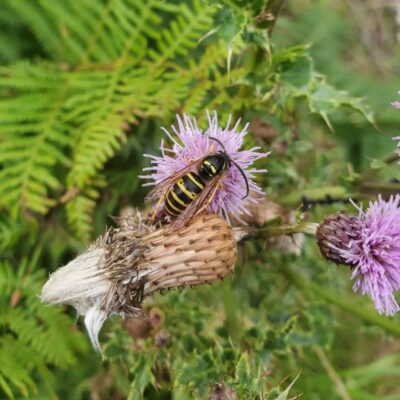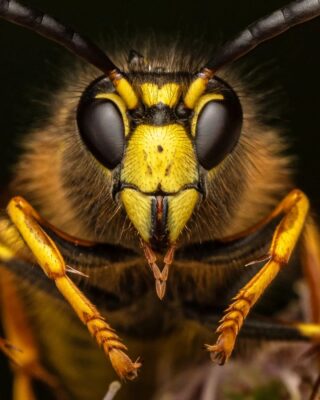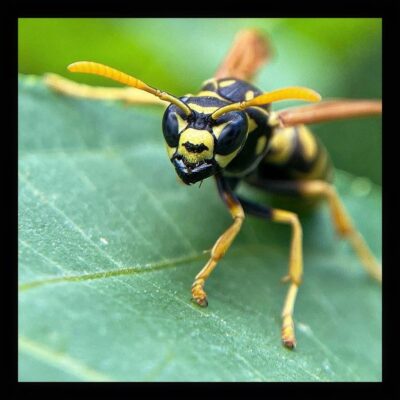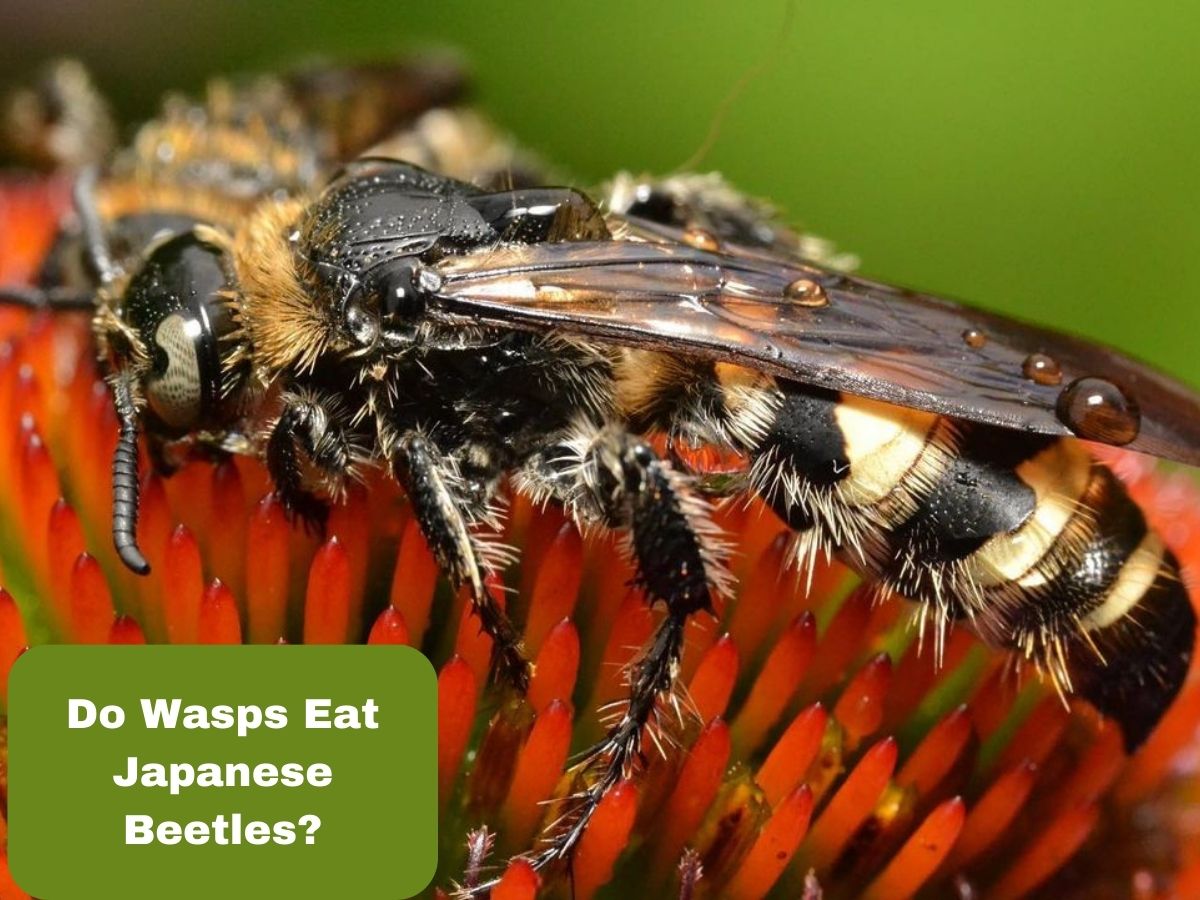Are you tired of battling those pesky Japanese beetles that munch on your precious plants? Well, guess what? Nature might just have a secret weapon to help you out – the remarkable wasps! Today, we’re diving deep into the intriguing world of “Do wasps eat Japanese beetles?” and exploring how these tiny predators play a crucial role in pest control.
The answer is a resounding yes! Wasps are not just buzzing annoyances; they’re skilled hunters with a taste for Japanese beetles. These tiny avengers seek out beetle larvae and use them as hosts for their eggs. Once the wasp offspring hatch, they feast on the immobilized grubs, putting a serious dent in the future generation of Japanese beetles.
But that’s not all – these winged warriors have a fascinating lifecycle and unique behavioral patterns that impact the beetle population. From their foraging habits to their seasonal fluctuations, understanding the wasp’s role in pest control is sure to leave you in awe.
So, let’s embark on this enthralling journey to discover how these tiny heroes bring balance to the ecosystem and keep your garden thriving.
The Predatory Nature of Wasps
When it comes to survival, wasps are true predators, and their feeding habits reflect their status as skilled hunters. Unlike bees, which primarily collect pollen and nectar, wasps are carnivorous and feast on other insects, making them valuable members of the ecosystem’s pest control squad.
Various wasp species have honed their predatory skills, each with its own unique approach to hunting. Some wasps are solitary hunters, while others live in colonies with a division of labor. Among the wasps known for preying on insects, there are two groups that stand out in the battle against garden pests like Japanese beetles:
- Cerceris Wasps: These ground-dwelling wasps belong to the Crabronidae family and are known for their keen interest in beetles. Female Cerceris wasps are exceptional beetle hunters. They locate their prey, usually small beetles, by visually scanning the ground. Once they spot a suitable target, they capture it and deliver a paralyzing sting, rendering the beetle immobile but still fresh for their young ones to consume. These paralyzed beetles become food storage for the wasp larvae, ensuring they have a ready-to-eat meal when they hatch.
- Tiphia Wasps: Belonging to the Tiphiidae family, Tiphia wasps are another group of wasps known for their insect-hunting prowess. These wasps are parasitic, with females laying eggs on or near beetle larvae, including Japanese beetle grubs. When the wasp larvae hatch, they burrow into the host larvae, consuming them from the inside out. This method of predation not only directly reduces the number of beetle larvae but also interrupts the beetle’s life cycle, further curbing their population.

The predatory nature of wasps is essential for the ecosystem, as it helps maintain a natural balance in insect populations. By controlling pest insects like Japanese beetles, wasps play a crucial role in preserving the health of plants and the overall biodiversity of their habitats. As we continue to learn more about these fascinating insects, we gain a deeper appreciation for the delicate ecological dance orchestrated by Mother Nature herself.
Introduction to Japanese Beetles
Japanese beetles (Popillia japonica) may be small, but their impact on plants and crops can be devastating. These voracious feeders are known for their insatiable appetite and their ability to cause significant damage in a short period. Understanding the extent of their destruction is crucial for gardeners, farmers, and anyone looking to protect their green spaces from these invasive pests.
- Defoliation: Japanese beetles are primarily foliage eaters. Adult beetles chew on the leaves of various plants, leaving behind a distinct, skeleton-like appearance. They consume the soft tissue between the veins, causing the leaves to appear lacy and damaged. If the infestation is severe, a plant may lose a substantial portion of its leaves, leaving it vulnerable and weakened.
- Flower and Fruit Damage: Besides devouring leaves, Japanese beetles have a knack for ruining flowers and fruits. They’re especially fond of roses and various fruit trees, such as apples and cherries. When feeding on flowers, they can hinder the plant’s ability to produce seeds, affecting its reproductive cycle. As for fruits, they leave unsightly scars and make them susceptible to rot and secondary infections.
- Impact on Crop Yield: In agricultural settings, Japanese beetles can wreak havoc on various crops, including corn, soybeans, and grapes. A severe infestation can lead to reduced crop yields and financial losses for farmers. Additionally, the weakened plants become more susceptible to diseases and other pests, compounding the damage.
- Attracting More Beetles: The presence of Japanese beetles can also attract more beetles, as they release pheromones that signal their location to other beetles. This can lead to a rapid increase in the beetle population and exacerbate the damage caused to plants and crops.
- Plant Stress and Death: Continuous feeding by Japanese beetles can stress plants, making them more susceptible to other environmental stresses, such as drought or extreme temperatures. In some cases, particularly young or already weakened plants, the damage can be severe enough to lead to plant death.
- Impact on Landscapes: Beyond the economic and agricultural implications, Japanese beetle infestations can ruin the aesthetics of carefully cultivated landscapes and gardens. Plants that were once vibrant and lush may quickly turn into a patchwork of damaged and dying foliage.
Given the destructive potential of Japanese beetles, early detection and management are vital to minimize their impact on plants and crops. Implementing integrated pest management strategies, such as the use of physical barriers, traps, and selective insecticides, can help keep their populations in check while preserving a healthy and thriving green environment.
Can Wasps Eat Japanese Beetles?
Can wasps eat Japanese beetles? Let’s delve into the fascinating world of these predatory insects to find out.
Wasps are opportunistic predators with diverse dietary preferences. While some wasp species primarily target other insects, including caterpillars, flies, and aphids, others have a particular appetite for beetle larvae.
These ground-dwelling wasps, like Cerceris and Tiphia species, exhibit a keen interest in Japanese beetle grubs. Once they locate their prey, they use their stingers to paralyze the grubs before transporting them to their nests, where they serve as a fresh food source for their developing offspring.
- Scientific Studies on Wasp Predation: The role of wasps in controlling Japanese beetle populations has been the subject of scientific research. Studies conducted by entomologists from various universities and research institutions have shed light on the significant impact of wasps on reducing beetle infestations. For instance, a study from the University of Maryland’s Department of Entomology revealed that Cerceris fumipennis wasps are highly effective in finding and capturing Japanese beetle grubs, offering valuable insights into natural pest control methods.
- Observations from Gardeners and Experts: Gardeners and agricultural experts alike have witnessed the beneficial impact of wasps in combating Japanese beetle populations. Many gardeners have reported observing wasps actively hunting and preying on Japanese beetle grubs in their gardens. These observations reinforce the notion that wasps are indeed significant contributors to managing these destructive beetles in natural ecosystems.
In conclusion, yes, wasps can and do eat Japanese beetles, particularly in their larval stage. Their feeding behavior and preferences, coupled with evidence from scientific studies and real-life observations, highlight the critical role of wasps as natural predators in controlling Japanese beetle populations.
By supporting and encouraging these eco-friendly pest controllers, we can take a step towards maintaining a healthy balance in our gardens and agricultural landscapes.
The Role of Wasps in Pest Control
Wasps are unsung heroes in the realm of pest control, and understanding their ecological significance unveils their vital role in maintaining a balanced ecosystem.
Ecological Significance of Natural Predators:
Nature has a way of achieving equilibrium, and the presence of natural predators, like wasps, is a crucial part of this delicate balance. In the intricate web of life, every organism plays a specific role, and wasps have evolved as efficient insect predators. Their selective feeding behavior helps keep insect populations in check, preventing outbreaks of certain pests.
By preying on insects like Japanese beetles, wasps act as nature’s pest controllers, limiting the potential damage these pests can cause to plants and crops. This natural regulation reduces the reliance on chemical pesticides, which can have harmful effects on the environment, beneficial insects, and even humans.
Benefits of Promoting Wasp Populations:
Encouraging and supporting wasp populations in gardens and agricultural areas offer several benefits for the environment and human activities.
- Effective Pest Management: By keeping pest populations under control, wasps contribute to healthier plants and higher agricultural yields. Reduced pest pressure means less need for chemical interventions, promoting a more sustainable approach to pest management.
- Biodiversity Conservation: A diverse range of insect species, including wasps, is essential for maintaining biodiversity. Promoting the existence of wasp species also supports the overall balance of the ecosystem, ensuring the survival of other creatures in the food web.
- Cost-Effectiveness: Embracing natural pest control through wasps can be cost-effective in the long run. Reducing the reliance on chemical pesticides not only saves money but also minimizes potential ecological and health risks associated with their use.
Integrated Pest Management (IPM) Strategies Involving Wasps:
Integrated Pest Management (IPM) is a holistic approach to pest control that combines various strategies to minimize pest damage while protecting the environment and human health. In IPM, wasps play a central role as one of the key natural predators.
Some IPM strategies involving wasps include:
- Habitats for Beneficial Insects: Creating suitable habitats for wasps, such as providing nesting sites and planting nectar-rich flowers, attract these valuable predators to the area.
- Biological Controls: Introducing or conserving natural enemies like wasps as a part of a biological control program can effectively manage pest populations without resorting to chemical pesticides.
- Monitoring and Thresholds: Regular monitoring of pest populations allows growers to intervene with targeted measures when necessary, utilizing wasps and other natural enemies as part of the control strategy.
In conclusion, wasps are essential players in the delicate dance of nature’s pest control. By promoting their populations and embracing their predatory nature, we can foster healthier ecosystems, protect our crops, and cultivate a more sustainable and harmonious coexistence with the natural world.

Attracting and Supporting Wasp Populations
Attracting and supporting wasp populations is a rewarding endeavor that not only aids in pest control but also enhances the ecological balance of your garden or agricultural area.
Creating a Welcoming Environment for Wasps:
To invite these beneficial insects into your space, consider providing a welcoming environment that meets their needs.
- Avoid Excessive Pesticide Use: Reducing or eliminating the use of chemical pesticides is crucial. Pesticides can harm not only the targeted pests but also beneficial insects like wasps. Embrace a more sustainable approach to pest management to preserve the delicate ecological balance.
- Water Sources: Like all living creatures, wasps require water. Providing a shallow dish with fresh water can be a simple way to quench their thirst and encourage their presence.
- Shelter and Protection: Wasps seek shelter during harsh weather conditions and for nesting purposes. Maintain natural areas like woodpiles or leaf litter, which serve as hiding spots and nesting sites for these insects.
Suitable Plants and Habitats to Attract Beneficial Wasps:
Certain plants act as natural magnets, enticing wasps with their nectar and providing valuable sustenance. Consider incorporating the following plant species into your garden or landscape:
- Dill (Anethum graveolens): This herbaceous plant produces attractive flower heads that appeal to adult wasps, providing them with a nourishing nectar source.
- Parsley (Petroselinum crispum): Parsley is another herb that attracts adult wasps with its tiny flowers, offering a reliable nectar supply.
- Yarrow (Achillea millefolium): Yarrow’s flat, umbrella-like flower clusters are irresistible to adult wasps, making it a valuable addition to your garden.
- Queen Anne’s Lace (Daucus carota): This wildflower is beloved by adult wasps for its abundant nectar.
Providing Nesting Sites for Wasps:
For wasps to thrive, they require suitable nesting locations. Ground-dwelling wasps, such as Cerceris and Tiphia species, prefer bare, sandy soil for nesting. Leave patches of undisturbed soil in sunny areas of your garden to provide nesting opportunities.
In addition to ground-nesting wasps, other species, like paper wasps and mud daubers, construct nests in sheltered areas. Offering artificial nesting options, such as wasp houses or wooden structures with nooks and crannies, can entice these wasps to settle in your garden.
Remember to place nesting sites away from frequently trafficked areas to minimize human-wasp interactions. Provide ample foraging opportunities nearby to support their needs throughout the season.
By creating an inviting environment, offering suitable plants, and providing nesting sites, you can transform your garden or agricultural space into a haven for beneficial wasps. These tiny superheroes will reciprocate by helping to keep pests in check, contributing to a flourishing and harmonious ecosystem.
Potential Risks and Concerns
Addressing misconceptions and fears about wasps is essential to promote a positive perception of these valuable insects. While wasps can be intimidating, understanding their behavior and implementing safety measures allows for peaceful coexistence.
Addressing Misconceptions and Fears About Wasps:
- Aggression vs. Defensiveness: Many people fear that wasps are aggressive creatures that actively seek to sting humans. In reality, wasps are generally non-aggressive and only sting when they feel threatened or their nest is disturbed. Understanding the difference between defensive behavior and aggression helps dispel misconceptions.
- Benefits of Wasps: Highlight the ecological significance of wasps as natural pest controllers. Emphasize their role in keeping insect populations in check, including pests that can damage crops and gardens.
- Beneficial vs. Harmful Wasps: Explain that not all wasps are harmful. Many wasp species are beneficial and contribute positively to the ecosystem, including those that prey on Japanese beetles.
Understanding Wasp Behavior and Potential Stinging Incidents:
- Keep a Safe Distance: When encountering wasps, it’s best to keep a safe distance and avoid sudden movements that might startle them. Observe them from a distance to appreciate their role in nature without disturbing their activities.
- Avoid Swatting: Swatting at wasps or trying to shoo them away can provoke defensive behavior and increase the likelihood of being stung. Instead, remain calm and slowly move away if you feel uncomfortable with their presence.
- Nesting Sites: Be aware of wasp nesting sites in your garden or property and avoid approaching them. If you need to work in the area near a wasp nest, do so during cooler periods when wasp activity is lower, such as early morning or late evening.
- Protective Clothing: If you anticipate being in close proximity to wasps, wearing long sleeves, pants, and closed-toe shoes can provide added protection against accidental stings.
Tips for Coexisting with Wasps Safely:
- Keep Food Covered: During outdoor gatherings, keep food and beverages covered to avoid attracting wasps. Wasps are opportunistic feeders and may become interested in exposed food.
- Choose Strategic Planting: If you have concerns about wasps near high-traffic areas, consider planting wasp-repelling herbs like mint or basil in those locations.
- Educate Children and Guests: Educate children and guests about wasp behavior and how to respond appropriately if they encounter them. Teaching respect for these beneficial insects promotes safer interactions.
- Professional Removal: If wasp nests are in areas that pose a significant risk, consider consulting a professional pest control service for safe removal.
By addressing misconceptions, understanding wasp behavior, and following safety guidelines, it’s possible to coexist with wasps peacefully. These remarkable insects are valuable allies in the natural world, playing an essential role in pest control and maintaining ecological balance. With proper awareness and respect for their presence, we can appreciate their contribution to a healthier and thriving ecosystem.

Other Natural Predators of Japanese Beetles
In addition to wasps, several other natural predators play a crucial role in keeping Japanese beetle populations in check. These predators contribute to a more balanced ecosystem and help reduce the impact of these destructive beetles. Some of the key natural predators of Japanese beetles include:
- Ground Beetles (Carabidae family): Ground beetles are nocturnal predators that actively hunt for insects on the ground, including Japanese beetle adults and larvae. They are voracious feeders and can significantly reduce beetle populations in gardens and agricultural fields.
- Birds: Many bird species, such as starlings, robins, and grackles, include Japanese beetles in their diet. They feed on the adult beetles as they forage on plants or fly in the open. Encouraging bird habitats, such as birdhouses and bird feeders, can attract insectivorous birds to your garden.
- Skunks and Raccoons: Skunks and raccoons are opportunistic feeders and will readily consume Japanese beetle grubs found in the soil. They can be beneficial in controlling larval populations, especially in lawns and grassy areas.
- Predatory Insects: Various predatory insects, like ladybugs (lady beetles), lacewings, and soldier beetles, also prey on Japanese beetle eggs, larvae, and adults. Introducing or conserving these beneficial insects can aid in reducing beetle infestations.
- Parasitoid Wasps: Apart from the ground-dwelling wasps mentioned earlier, some parasitoid wasps are specialized in attacking Japanese beetle grubs. These wasps lay their eggs inside the grubs, which eventually leads to their demise.
- Nematodes: Certain species of nematodes, known as entomopathogenic nematodes, can parasitize and kill Japanese beetle grubs in the soil. These microscopic worms are harmless to plants and animals but highly effective against beetle larvae.
- Frogs and Toads: Some amphibians, such as frogs and toads, include Japanese beetles in their diet. Having a water feature in your garden can attract these insect-eating amphibians.
Encouraging a diverse and healthy ecosystem with a variety of habitats and food sources will naturally attract and support these natural predators. By promoting a thriving community of beneficial insects, birds, and animals, you can maintain a natural balance that helps keep Japanese beetle populations at bay without relying heavily on chemical pesticides.
Do Wasps Eat Japanese Beetles FAQs?
Are Wasps Harmful to Humans?
While wasps can sting, they are not inherently harmful to humans unless provoked or threatened. Wasps sting as a defense mechanism, especially if they feel their nest is under attack. Most wasp stings result in localized pain, redness, and swelling.
However, some individuals may experience allergic reactions, which can be more severe. It’s essential to avoid disturbing wasp nests and give them space to carry out their natural activities. Coexisting with wasps safely involves understanding their behavior and taking precautions to minimize the risk of stings.
How Can I Differentiate Between Japanese Beetles and Other Beetles?
Japanese beetles have distinctive characteristics that set them apart from other beetles. They are about half an inch long with an iridescent green and copper-colored body.
The wing covers have five tufts of white hairs on each side. Additionally, their thorax is metallic green, and they have two white tufts of hair on the side of their abdomen. Adult Japanese beetles are known for their voracious appetite and tendency to feed on a wide variety of plants, causing significant damage to foliage and flowers.
Are Wasps Dangerous to Humans and Pets?
Wasps can be a potential threat to humans and pets if their nests are disturbed, leading to defensive behavior and stinging incidents. Most wasp stings cause temporary pain and discomfort, but allergic reactions can occur in some individuals.
Pets may also be at risk if they accidentally disturb a wasp nest. While wasps can be intimidating, they play an essential role in the ecosystem as natural predators of various insect pests. Taking precautions and avoiding disturbances near their nests can help coexist with them safely.
What are the Signs of a Japanese Beetle Infestation in My Garden?
Signs of a Japanese beetle infestation in your garden include:
- Skeletonized Leaves: Adult Japanese beetles feed on leaves, often leaving them skeletonized or with only the veins remaining.
- Damaged Flowers and Fruits: Japanese beetles also consume flowers and fruits, leaving behind visible damage like chewed petals and scarred fruits.
- Groups of Beetles: Japanese beetles are social insects, and you may spot groups of them congregating on plants or flying in the area.
- Presence of Grubs: In late summer and early fall, you might encounter white, C-shaped beetle grubs in the soil, which are the larvae of Japanese beetles.
Are There Any Chemical-Free Methods to Control Japanese Beetles?
Yes, there are several chemical-free methods to control Japanese beetles:
- Hand-Picking: For small infestations, manually remove adult beetles from plants and drop them into a bucket of soapy water.
- Floating Row Covers: Use floating row covers to physically block adult beetles from accessing plants.
- Companion Planting: Planting repellent herbs like garlic, chives, and tansy can deter Japanese beetles from your garden.
- Neem Oil and Soap Sprays: These natural sprays can help deter and disrupt Japanese beetles’ feeding behavior.
- Beneficial Nematodes: Introduce entomopathogenic nematodes into the soil to target Japanese beetle grubs.
By implementing these chemical-free methods, you can manage Japanese beetle populations while minimizing the use of harmful pesticides and preserving the health of beneficial insects and the environment.
Conclusion
Understanding the intricate relationship between wasps and Japanese beetles sheds light on the invaluable role of natural predators in maintaining a harmonious ecosystem. Wasps, with their voracious appetites for beetle larvae, play a vital part in regulating Japanese beetle populations, thereby mitigating potential damage to plants and crops.
By creating a welcoming environment for beneficial wasps in our gardens and agricultural areas, we can promote a sustainable approach to pest management. Supporting their populations through strategic planting, providing nesting sites, and avoiding disturbance of their nests fosters a balanced coexistence with these remarkable insects.
Addressing misconceptions and fears about wasps encourages appreciation for their ecological significance while understanding their behavior helps ensure safe interactions. Identifying signs of a Japanese beetle infestation allows timely intervention while implementing chemical-free control methods promotes eco-friendly alternatives.
Ultimately, embracing the natural pest control prowess of wasps and other predators empowers us to cultivate healthier, thriving ecosystems that benefit both human activities and the diverse array of life in our surroundings. As we navigate the intricacies of nature’s dance, let us remember the value of these small yet impactful creatures, guardians of our green spaces and allies in the intricate tapestry of life.
